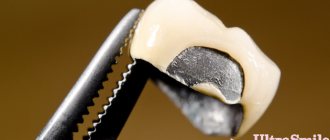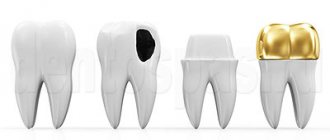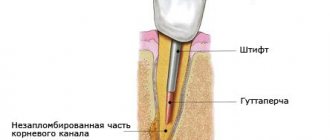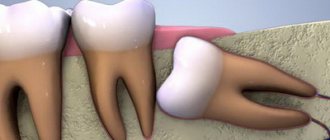Ancient dentures
The first prototypes of dentures for the upper jaw were discovered during excavations of Egyptian tombs. After carefully studying these impressive artifacts, scientists came to the conclusion that even in ancient Egypt, priests wondered “How to make dentures” and widely used slave teeth and ivory dentures for this purpose, which were tied with wire to adjacent teeth. In the tombs of the Etruscans (9th-39th centuries BC), during excavations in the city of Tarquinia, a denture for the jaw was found, made from animal fangs with fastenings in the form of gold rings. And only in the 11th century AD. The beginning of dental prosthetics, as a separate direction in dentistry, was laid by the Arab surgeon Abul-Kassem, who proposed splinting teeth with wire made of precious metals.
Further development of orthopedic dentures took place in Europe. In the 16th century, the French surgeon Ambroise Paré thought about how to install dentures and came up with designs consisting of interconnected artificial teeth made of ox bone, ivory and even wood. However, later, the teeth of deceased people, for example, soldiers who died during military battles, were more often used for prosthetics. The first porcelain dentures, most similar to modern ones, were made in the 19th century, but the bases for them were still made of wood, ivory and gold. It was only in 1848 that these materials were replaced by rubber. Our country has also made a significant contribution to the development of technology for the manufacture of dentures. Russian researchers introduced the production of dentures from acrylic plastic and discovered the suitability of stainless steel for the manufacture of fixed dentures.
Duration of service in dentistry: legal content
A. V. Panov
medical lawyer, manager of Center for Medical Law LLC, editor-in-chief of the information portal Pravo-med.ru
In the previous publication (De№tal Мagazi№e No. 12 (144), 2015), warranty periods in dentistry were discussed. Let me remind you that the warranty period is a voluntary obligation of the dental clinic within a designated period of time during which the medical organization undertakes to exercise the rights of the consumer.
These rights are established by Art. 29 of the Law of the Russian Federation dated 02/07/1992 No. 2300-1 “On the protection of consumer rights”, namely:
- eliminate deficiencies in the work performed free of charge;
- reduce the price of work performed;
- redo the job;
- reimburse the consumer for the costs incurred to eliminate deficiencies in the work performed by third parties (other dental clinics);
- accept the consumer’s refusal to fulfill the contract for the performance of work and compensate the consumer in full for the losses incurred by him if, within the period established by the specified contract, the shortcomings of the work performed are not eliminated by the medical organization;
- accept the consumer’s refusal to fulfill the contract for the performance of work if he discovers significant deficiencies in the work performed or other significant deviations from the terms of the contract.
In interaction with the warranty period is such a concept as service life, which is understood as the period during which the dental clinic undertakes to provide the consumer with the opportunity to use the work for its intended purpose and bear responsibility for significant deficiencies on the basis of the Russian Federation Law “On the Protection of Consumer Rights”.
The use of work for its intended purpose is associated with the materialized result of dental activity - a filling, an orthopedic structure that replaces pathologically altered tissues or defects in the dentition in order to eliminate, first of all, the insufficiency of the function of biting and chewing food.
If the dental clinic has not indicated the service life of the filling or orthopedic structure, then the consumer will be able to “download rights” legally for 10 years. If the filling or orthopedic structure does not provide the above-mentioned functional purpose: for example, loss of the filling, its mobility, violation of the integrity of the crown of the bridge (including chipping of the lining), loose fit of the crown to the ledge or neck of the tooth, fracture of the prosthesis, decementing of fixed prosthetic structures, and, thus, there will be significant shortcomings in dental work, which are understood as significant deviations from the needs (interests) of the consumer, when the result of the work cannot be used, or the consumer is significantly deprived of what he had the right to count on when concluding the contract.
If there is a service life established by the dental clinic and a significant deficiency in the dental work, the consumer’s next right is “switched on” - only the free elimination of defects in the work, while the consumer is obliged to prove that the defects arose before the acceptance of the work or for reasons that arose before that moment. Such reasons may be inappropriate professional actions of a dentist, the use of low-quality (counterfeit) medical products, medications, etc....
Therefore, it is important to record in the medical record of the dental patient, in the act of providing services, the date of completion of the work and its transfer to the consumer.
As we can see, the scope of consumer rights within the service life is significantly lower than during the warranty period. However, if within a 20-day period the consumer’s demand is not satisfied by the dental clinic, the following powers are added to him:
- corresponding reduction in the cost of work performed;
- reimbursement of expenses incurred by him to eliminate deficiencies in the work performed on his own or by third parties;
- refusal to fulfill the contract for the performance of work and compensation for losses.
Establishing a service life, as well as a warranty period, is a right, not an obligation, of a dental clinic.
However, the legislator motivated the service provider to establish a service period. How?
The fact is that, according to the law “On the Protection of Consumer Rights”, a demand for gratuitous elimination of defects can be made after two years from the date of acceptance of the work result, but within the service life established for the work result or within ten years from the date of acceptance the result of work by the consumer, if the service life is not established.
Thus, if the dental clinic has not indicated the service life of a filling or orthopedic structure, then the consumer will be able to “download rights” legally for 10 years.
Therefore, my recommendation as a medical lawyer is that for dental work it is necessary to indicate the service life (it can be formally minimal at two years and one day), after which the rights of the consumer discussed above cease. A dental clinic can determine the specific service life based on its statistical data, the clinical experience of the doctor, the characteristics of consumables, the condition of the patient’s oral cavity and... marketing policy.
And, of course, it is necessary to identify the significant shortcomings of dental work so that they are clear to the consumer. Despite the fact that healing is an art, formalities accompanying it, in the form of legal norms regulating dental activities, still have to be fulfilled, and service life is one of them.
New generation dentures
Today, patients considering which dentures are best to have a huge choice of designs made of biocompatible materials created using innovative technologies, for example, using a computer CAD/CAM system. Low-traumatic methods of orthopedic treatment and high quality dentures made of metal ceramics, ceramics and zirconium dioxide allow you to quickly and effectively restore the functions and aesthetics of the dentition, without causing harm to healthy teeth and even prolonging their life. Of course, the price of a new generation of dentures is quite high, but these costs will be fully justified by your new smile, flawless in all respects. Besides, nowadays you don’t have to worry about how dentures look. Orthopedic products made from any materials look natural and aesthetically pleasing, and diction does not suffer from modern dentures. Plus, if any problems arise with the design, you can always contact the same dentistry where it was installed for you, since all clinics, without exception, offer a guarantee on dentures.
How long do dentures last?
Prostheses are installed separately. Their service life may differ from implants. It is determined by the material from which the crowns are made:
- metal-plastic or plastic crowns - last from several weeks to several months due to the insufficient strength of the plastic. They can be installed temporarily while a permanent denture or crown is being made. The maximum service life of plastic structures is 2-3 years;
- metal ceramics. These are crowns made of metal, coated with a ceramic layer. They look good, are durable, reliable, and last 10-12 years. With care and proper dental care, this period can be much longer. Most often, the enamel of metal ceramics chips, cracks appear on the surface, and because of this it has to be replaced;
- metal-free ceramics and zirconium dioxide are the most durable, lasting 15-25 years. Almost never require replacement.
If a short-lived prosthesis is used for implantation, it will have to be replaced, which creates a risk of complications. Doctors at the Dentospas clinic recommend using the most reliable, durable designs and materials.
Types of dentures
Now let's talk about what types of dentures there are. Currently, in dentistry there are various designs for replacing one or more teeth, as well as for total prosthetics of an entire dentition. Based on the method of fastening dentures in the oral cavity, they are divided into the following categories.
Removable
The design of removable dentures consists of a base - a base and artificial crowns located on it. Such structures can be complete - to replace all the teeth of one jaw - or partial. As for the types of removable dentures, according to their structure they are classified into plate ones, which are attached to the palate by suction, and clasp structures with locks-attachments or clasps for fixation on the supporting teeth. They are easy to use, and usually patients do not have questions about how to install the structure themselves, or how to remove the denture for hygiene procedures or at night. Unlike other types of orthotics, repairing removable dentures in most cases helps extend the life of the dentures. Removable structures are of the following types:
- Nylon
- Acrylic
- Acrylic-free
Conditionally removable dentures
This type includes complete plate dentures for replacing all teeth supported on implants. This is the best option for those who value high quality but want to save money on prosthetics. In this case, both the upper denture and the lower denture are attached to artificial roots with special cement, and only a dentist can remove them if necessary. The main indication for the use of conditionally removable dentures is the inability to install a large number of artificial roots due to inadequate quality of bone tissue or due to lack of funds. Reviews of these types of dentures indicate that they represent excellent value for money.
Fixed
With the help of this type of orthopedic structures, damaged teeth (enamel, cracks, chips and other defects) are restored. They are also used in orthopedic treatment for the loss of one or more teeth. Only a doctor can correctly remove a denture from the non-removable category. And their service life, as a rule, depends on how responsibly the patient will take care of him, and on the types of dentures used.
- Tabs.
These are microprostheses made of composite materials, ceramics or zirconium oxide, which are manufactured in dental laboratories and are used instead of fillings if the tooth is destroyed by more than 1/3. High-quality dental inlays fit tightly to the tooth and protect it from further destruction.
- Veneers.
Thin onlays for correcting the color, shape and eliminating various defects of the front teeth. They are produced directly and indirectly. The direct method involves the formation of veneers from a composite material directly on the patient’s ground teeth, and the indirect method involves the creation of ceramic or zirconium oxide plates based on dental casts in dental laboratories. Orthopedic veneers are considered a new generation of dentures.
- Dental crowns.
These structures are caps made of biocompatible materials that are placed on the ground teeth and fixed with dental cement. Crowns are used when more than 2/3 of a tooth is destroyed. In addition, a dental crown can be used to restore a completely missing tooth by securing it to an installed implant.
- Bridge prosthesis.
These are permanent orthopedic structures consisting of two crowns and artificial teeth between them. The installation of bridge-type dentures is carried out using grinded teeth or implants implanted into the jawbone. In this case, a proper dental bridge should serve to replace no more than two missing teeth in a row.
- Implant.
An artificial tooth root that is implanted into the jaw bone and serves as a support for a separate crown, bridge, or full denture when replacing the entire dentition. The orthopedic structure is attached to the implant using an abutment retainer or dental cement. Implants usually come with a lifetime warranty and are permanent dentures and do not need to be replaced.
The main factors for the longevity of dentures
The service life of a prosthetic structure greatly depends on the quality of its material.
One of the factors influencing the service life of a denture is the professionalism, qualifications and experience of the prosthetist. This should always be taken into account when choosing a dental clinic and doctor.
To timely eliminate problems with the prosthesis, it is necessary to regularly visit the orthopedist who installed it.
Even after installing the prosthesis, the orthopedist will monitor its condition and eliminate possible problems in a timely manner, but for this you need to visit him regularly.
The condition of the denture and its durability depend on how its owner treats it. Moreover, it affects not only how he follows medical recommendations for care and use, but also the possible development of certain diseases. But careless care can reduce the life of a denture by almost half.
Removable dentures:
- Partial dentures are dentures that can be made when a patient is missing one tooth or a group of teeth. Even if the patient has only one tooth left in the jaw, this denture will still be partial
- Complete removable dentures are structures that are made in the absence of teeth.
- Clasp dentures or arched ones. (Bügel translated from German means arc). The arch connects the elements of the prosthesis to each other and is made of metal. Clasp dentures are smaller and, as a result, more comfortable than conventional removable dentures
Materials for the manufacture of removable dentures are acrylic plastic, nylon, acrylic-free plastic (acry free), metal + plastic (clasp dentures, removable dentures on attachments and on a beam).
Acrylic removable dentures.
Prostheses made from acrylic plastics are quite cheap, but have a number of serious disadvantages. For example, these may be allergic reactions to acrylic, unaesthetic appearance (due to the use of wire (metal) clasps that are visible on the teeth), supporting teeth must be covered with crowns since the clasps that secure the prosthesis lead to damage to the teeth. Also due to the fact that outdated manufacturing technology does not allow making an acrylic prosthesis accurately for its good fixation on the jaw. It is made to cover almost the entire palate. Which negatively affects the patient’s taste and temperature sensitivity; diction also suffers due to a completely closed palate. Acrylic dentures are the most difficult dentures for a patient to get used to. The service life of this prosthesis is up to 15 years if maintenance and relining (adding plastic) of the prosthetic bed are carried out periodically.
Nylon prostheses.
These are dentures that are much more comfortable than acrylic ones. They don't cover the entire sky. And as a result, the patient is more comfortable speaking and eating in them. They are more aesthetically pleasing than acrylic ones due to the use of nylon rather than metal clasps, which are fixed to the teeth and imitate gums. These clasps are also safe for the patient’s teeth and there is no need to cover the supporting teeth with crowns. The disadvantages of nylon prostheses include their fragility (maximum 5 years) and the impossibility of their repair. These prostheses are recommended to be used as temporary prosthetics before, during and after the installation of implants, before prosthetics with fixed structures.
Acry free.
Acrylic-free removable dentures are manufactured using the same technologies as nylon ones and have the same advantages. But they do not have the disadvantages of nylon prostheses. That is, they are aesthetic, functional, comfortable, durable and can be repaired. The only drawback of these prostheses is the cost, which is almost 2 times higher than the price of an acrylic prosthesis. Service life is up to 15 years, with regular maintenance and relocation.
Clasp dentures.
The frame of clasp dentures is made of metal and combines saddle-shaped overlays with artificial teeth and clasps or locks that are attached to the crowns of the patient’s teeth. The advantage of these prostheses is that they are very comfortable. They practically do not cover the sky (a thin strip of metal, an arc, runs across the sky). Very well fixed, strong and durable. The disadvantages of these dentures are that you need to take a large number of teeth under the supports and cover them with crowns, more frequent maintenance, the impossibility of repair if the metal frame is deformed or broken, and the price.
Removable dentures on implants.
These prostheses include attached prostheses and bar prostheses. Such dentures are used if a conventional removable denture, due to loss of jaw bone tissue, does not fit well and falls. Implants are used to improve fixation. Attachments or beams are screwed to them, and the mating parts of these attachments or beams are welded into the prostheses.
When making a prosthesis on attachments, it is necessary to install at least 4 implants. The outer part (attachment) is screwed onto these implants, which can be either spherical or cylindrical in shape, and a mating part is installed in the prosthesis, which is fixed to this attachment and the prosthesis fixed to these attachments turns out to be quite stable, well fixed, comfortable because With these prostheses, the part covering the palate can be significantly removed. For strength, a metal frame is welded into the prosthesis.
Removable denture on a beam.
Before making these prostheses, 4 implants must be installed. A titanium beam is made for these implants, which connects all 4 implants into a single block. And this ensures their ability to take on significant loads. Unlike prostheses with attachments, where the implants are disconnected and experience more uneven loads. The prosthesis has a mating part welded into plastic and a metal frame necessary for strength. This prosthesis is made with a completely open palate, located only on the alveolar ridge. And it is very convenient for patients. Thanks to powerful fixation and a small area of the closed gum.
Fixed dentures:
Fixed dentures allow you to achieve high aesthetic and functional results. These dentures are the most comfortable and after a short time patients perceive them as their own teeth. Caring for these dentures is practically no different from your own teeth.
Fixed dentures include
- microprostheses: inlays, veneers, lumineers, these are prostheses that allow you to replace part of the crown of a tooth in order to restore it or improve the aesthetics of the tooth. For the manufacture of these prostheses, pressed ceramics are used, from which the frame is made and ceramic mass is applied on top
- crowns: this is a highly aesthetic and fully functional design that allows you to completely restore the coronal part of the tooth. And if it is necessary to improve aesthetics, change the shape of the tooth crown. These prosthetics include crowns and bridges on your teeth and on implants. If the tooth is destroyed by more than ⅔, then pin-stump inlays are made to restore the missing volume of tissue. They are made from cobalt-chromium alloy or zirconium dioxide
The materials for the manufacture of crowns and bridges are metals: cobalt-chromium alloys, nickel-chrome alloys, titanium, gold. Metal-free materials are also used: zirconium dioxide, pressed ceramics, feldspar.
Metal-ceramic crowns
- These are crowns consisting of a cast or milled metal cap and ceramic mass. After applying the ceramic, the crowns are baked in special vacuum ovens at temperatures up to 1000°C. These dentures completely imitate your teeth. They are durable and comfortable. The patient quickly gets used to them and begins to perceive them as his own teeth. The color of the future crown is selected according to the color of the patient’s teeth, so that they do not differ from their own teeth. There are a number of disadvantages to these crowns: they are not suitable for patients with allergies to metals. Over time, the edge of the crown near the gum begins to darken and this indicates oxidation of the metal; the edge of the gum adjacent to the crown may turn dark. There is also one nuance with aesthetics. If the patient does not have transparent enamel, then metal ceramics are ideal. But if the enamel is transparent, then the crown will stand out from the rest of the teeth. This is due to the fact that the technician, trying to hide the metal cap under the ceramic, applies non-transparent layers in the lower third of the crown, and when its thickness at the edge is less than a millimeter, the ceramic layer turns out to be thin and not transparent. The ability of such a crown to transmit light in the lower third is significantly different from its teeth and the tooth appears dull, not alive. Such crowns can be placed on chewing teeth where aesthetics can be neglected in favor of savings. It is better to place crowns of a higher class on the front teeth.
Crowns based on zirconium dioxide.
These crowns are precisely the next step in the evolution of orthopedic dentistry. In these crowns, the material used to make the cap is not metal, but the mineral zirconium dioxide. And it is also applied on top with ceramic mass and fired in a kiln. But, unlike the metal cap, it is transparent. And it can be given whatever color is needed to completely imitate the internal structure of the patient’s teeth. Since zirconium dioxide does not need to be hidden, the technician applies layers of ceramics that are as close as possible in terms of light transmission to the patient’s enamel and dentin. And as a result, we get a fantastic imitation of a living crown that is no different from the patient’s other teeth. In addition, such crowns are devoid of other disadvantages of metal-ceramics. Zirconium dioxide does not oxidize and does not darken along the edge even after 15 years. Previously, such crowns were made only abroad and cost exorbitant amounts of money. Since the technology for milling zirconium caps and bridge frames is quite complex and is produced using expensive equipment. Now all this exists in Russia. The prices for these crowns have become much more affordable and they cost slightly more than metal-ceramics.











